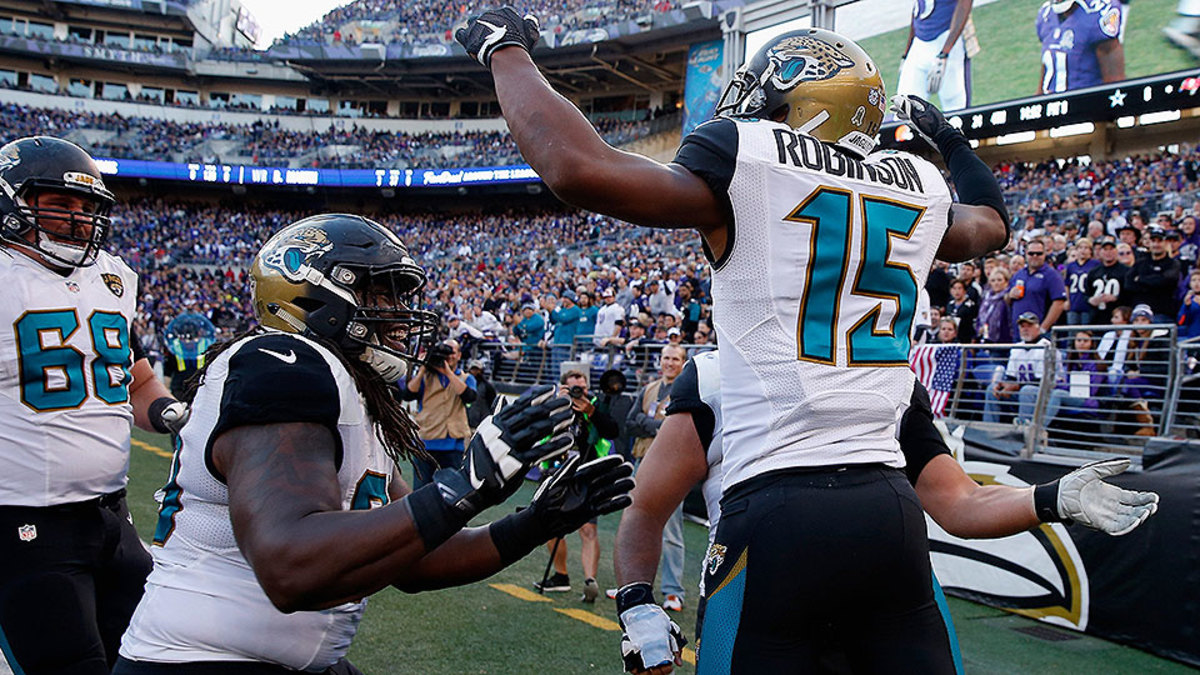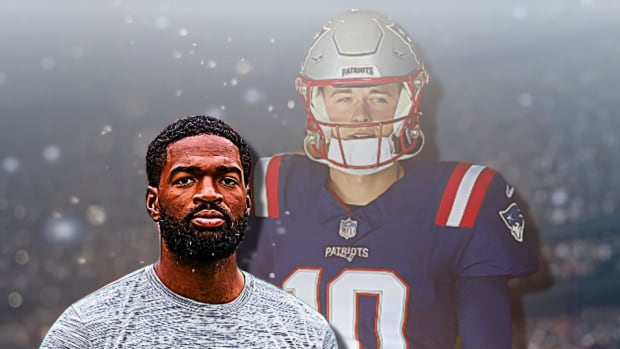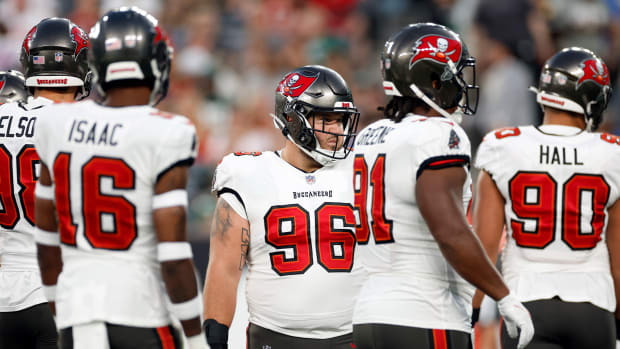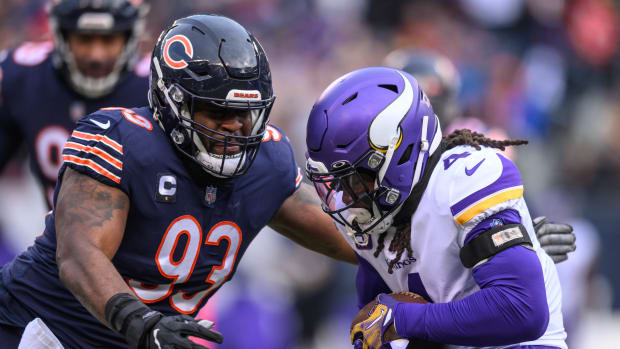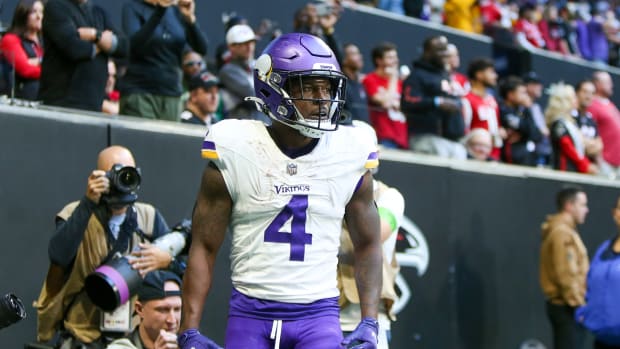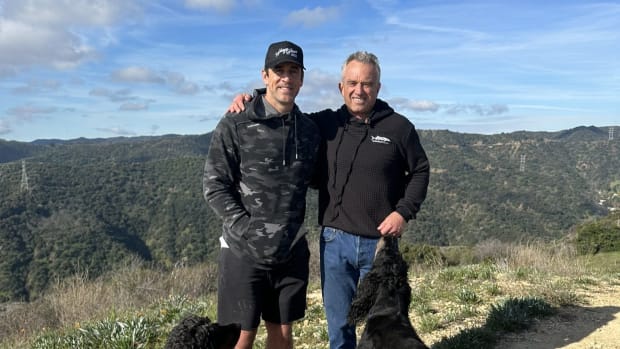Thanks to the 2014 draft, Jaguars’ O should rule the air for years to come
The Jaguars have been trying to join the ranks of the NFL’s credible franchises since Shad Khan bought the team from Wayne Weaver in November 2011. At that time, it was a franchise in disrepair, and Khan’s son Tony (who oversees the sabermetric side of things) knew that it would be a long haul. Ahead of the 2013 season, Jacksonville hired general manager Dave Caldwell and coach Gus Bradley, and that duo has overseen teams that produced a 12–36 record in the ensuing four seasons. The Khans have always said that they understood the long-term nature of such a rebuild, after the team’s 5–11 record in 2015, though, Shad Khan started speaking with a bit more urgency.
“One of the temptations is that everybody thinks they have a remodeling project on their hands,” he told USA Today this week. “There are some teams—the Jaguars would be one—that really, no, it’s a teardown.”
When Caldwell was hired, he told Khan that the path to success was through the draft, as opposed to the quick fixes of free agency. The Jaguars stuck with that plan and protected their cap space during Caldwell’s first three seasons, but this spring, they broke the bank for defensive lineman Malik Jackson and safety Tashaun Gipson, as well as running back Chris Ivory. Those transactions should help a defense and run game in need of improvement, if only to catch up with the pace of an exciting passing offense that took a big leap forward in 2015.
The three stars of that aerial attack—quarterback Blake Bortles and receivers Allen Robinson and Allen Hurns—are the jewels of the rookie class Caldwell assembled in ’14, proving his team-building philosophy right and paying the kind of dividends that could make Jacksonville one of the NFL’s most explosive passing games.
A closer look at how each of those three third-year stars have set up the Jaguars to terrorize defenses through the air for years to come.
Blake Bortles (Round 1, pick No. 3)
It wasn’t the plan to start Bortles in his rookie year. Injuries to Chad Henne forced then offensive coordinator Jedd Fisch to throw Bortles into the NFL fire, and he was not ready at all. He had clear issues with reading the field and moved himself into many of his league-leading 55 sacks. The Jaguars’ suspect pass protection and the small amount of time Bortles had to get in sync with his receivers didn’t help, either.
What was most impressive about that rookie season is how Bortles bounced back from it. His big leap in 2015: 4,428 yards, 35 touchdowns and 18 interceptions. Yes, those 18 picks led the league, and yes, he only moved up from 44th to 25th in Football Outsiders’ opponent-adjusted efficiency metrics for quarterbacks, but like the progress of the Jaguars at large last season, you have to grade the on-field results on a curve. Under new offensive coordinator Greg Olson, the passing game went vertical, with higher risk/reward factors than the usual dink-and-dunk. Bortles led the league with 1,330 yards on passes that traveled 20 yards in the air or more.
• SI’s 2016 position rankings: How do the best of the best stack up?
When this vertical game works, it’s very tough for defenses to stop, and it all starts with consistent mechanics and quick reads from Bortles himself. This throw to Robinson against the Saints in Week 16 shows how well Bortles times the long ball with his deep receivers. Yes, it helped that he was going against a New Orleans defense that seemed incapable of providing pressure—on this play, cornerback Brandon Browner has no shot whatsoever against Robinson’s vertical speed—but it’s still a good place to start. When your quarterback can sling the ball 40 yards downfield, across his body, with minimal effort, you have a guy around whom you can build a sustainable vertical offense.
Of course, like any deep passing game throughout history ... when it doesn’t work, it really doesn’t work. This interception against the Texans in Week 17 shows how Bortles still has to improve when it comes to reading changing defensive concepts. Bortles has a 3-by-1 coverage to read on his front side, with slot cornerback Kareem Jackson moving at the snap to reinforce that coverage as the third man. Safety Andre Hal takes advantage of Bortles’s inability to sort that out, and with Robinson taking outside position, there’s almost no way this pass can be completed. On the opposite side of the field, Bortles has two different one-on-one matchups he doesn't exploit. The best quarterbacks read the field quickly and decisively enough to take advantage of the holes in disguised coverage, and Bortles simply isn't there yet. Addressing that weakness would add much-needed consistency to the Jaguars’ offense.
Allen Robinson (Round 2, pick No. 62)
Robinson was a high-volume receiver at Penn State, with 174 catches for 2,450 yards and 17 touchdowns in his final two seasons. The Jaguars were impressed with his combination of open-field speed and ability to get yards after the catch.
It took awhile for Robinson to bring that same impact to the NFL. He started eight games in his rookie season, catching 48 passes for 548 yards and two touchdowns and dealing with hamstring and foot injuries. His second season was a revelation, as he became the most prolific deep receiver in the league: His 30 receptions of passes traveling 20 or more yards in the air led the NFL, and he finished a Pro Bowl campaign with 80 catches for 1,400 yards and a league-high 14 touchdowns.
• The ideal NFL dynasty of the next five years: Offense | Defense
And Robinson is not just a straight-up speed receiver. His route awareness took a leap forward last season. Yes, he’ll fry cornerbacks downfield, but watch how he slow-plays Dolphins cornerback Jamar Taylor and safety Walt Aikens on this 46-yard touchdown from Week 2. Taylor has to split his focus between Robinson’s deep route and the out route to the sideline run by Rashad Greene, and when Robinson jabs to the outside, Aikens finds himself in a very bad position: He either has to follow the jab-step or stay over the top knowing that it’s where Robinson is going to go. Aikens guesses wrong, Robinson doesn’t allow any makeup time, and Bortles has an easy pitch-and-catch in the face of an A-gap blitz.
Allen Hurns (UDFA signing)
Hurns wasn’t on anyone’s list to be drafted, but he starred in the preseason with 14 catches for 232 yards and became the second player in NFL history to score touchdowns on his first two regular-season receptions in a Week 1 loss to the Eagles. Hurns regressed at times, showing issues with focus drops, but he led the team in receiving yards (677) and receiving touchdowns (six). Hurns’s development in 2015 had a lot to do with his growth as a weapon inside—he had 29 slot catches for an impressive 511 yards and seven of his 10 touchdowns last season. Hurns uses his size to get open in the red zone from the slot, and like Robinson, his improvement in route awareness over the last couple of years is noticeable. Every team in the league missed on Hurns coming out of college, and the Jags made sure he’ll be in Jacksonville for a while by signing him to a five-year, $40.6 million contract extension in June.
This five-yard touchdown against the Ravens in Week 10 illustrates how Hurns has become such an effective touchdown target. Watch him sell the outside curl and then turn back inside, distancing himself from Baltimore cornerback Jimmy Smith in man coverage. This is the same kind of route concept you’ll see Patriots receiver Julian Edelman use against man coverage in the red zone, and Hurns runs this as well as anyone.
Robinson and Hurns are Bortles’s most effective weapons, but not his only ones. If receiver Marqise Lee (also selected in the second round of the 2014 draft) and tight end Julius Thomas (given a five-year, $46 million free agent contract in 2015) can overcome the injury issues that have held them back in this offense, the Jaguars could have one of the most diverse passing games in the NFL.
It has taken a long time for the Jaguars to get here, but good things are starting to happen. Their patience could be rewarded, starting this season.
































